Aqueous-Phase Reforming of Biogas Slurry over MOF-Derived α-MoO3 Catalyst for Producing Renewable Hydrogen: Effect of Fermenting Time
Abstract
1. Introduction
2. Results and Discussion
2.1. Characterization of Catalysts
2.1.1. Phase and vdW Heterostructures Analysis
2.1.2. Surface Property Analysis
2.2. Pollutant Treatment Capability
2.3. Hydrogen Production
Produced alkenes: nCO + 2nH2 → CnH2n + nH2O, ΔH > 0
2.4. Compositions of Liquid Phase
2.4.1. Organic Components
2.4.2. Inorganic Components
3. Materials and Methods
3.1. Materials
3.2. Preparation of the Catalysts
3.3. Anaerobic Digestion Process
3.4. Aqueous-Phase Reforming Experiments
3.5. Data Analysis
3.6. Analytical Methods
4. Conclusions
Supplementary Materials
Author Contributions
Funding
Institutional Review Board Statement
Informed Consent Statement
Data Availability Statement
Conflicts of Interest
References
- Wang, Z.; Li, J.; Yan, B.B.; Zhou, S.Q.; Zhu, X.C.; Cheng, Z.J.; Chen, G.Y. Thermochemical processing of digestate derived from anaerobic digestion of lignocellulosic biomass: A review. Renew. Sustain. Energy Rev. 2024, 199, 114518. [Google Scholar] [CrossRef]
- Jiang, H.E.; Deng, F.; Luo, Y.P.; Xie, Z.J.; Chen, Y.C.; Zhou, P.; Liu, X.F.; Li, D. Hydrothermal carbonization of corn straw in biogas slurry. J. Clean. Prod. 2022, 353, 131682. [Google Scholar] [CrossRef]
- Lu, Y.; Li, J.M.; Meng, J.; Zhang, J.; Zhuang, H.F.; Zheng, G.Y.; Xie, W.Y.; Ping, L.F.; Shan, S.D. Long-term biogas slurry application increased antibiotics accumulation and antibiotic resistance genes (ARGs) spread in agricultural soils with different properties. Sci. Total Environ. 2021, 759, 143473. [Google Scholar] [CrossRef] [PubMed]
- Zeng, W.S.; Qiu, J.R.; Wang, D.H.; Wu, Z.Y.; He, L.T. Ultrafiltration concentrated biogas slurry can reduce the organic pollution of groundwater in fertigation. Sci. Total Environ. 2022, 810, 151294. [Google Scholar] [CrossRef] [PubMed]
- Liang, F.H.; Xu, L.; Ji, L.; He, Q.Y.; Wu, L.L.; Yan, S.P. A new approach for biogas slurry disposal by adopting CO2-rich biogas slurry as the flower fertilizer of Spathiphyllum: Feasibility, cost and environmental pollution potential. Sci. Total Environ. 2021, 770, 145333. [Google Scholar] [CrossRef]
- Zoppi, G.; Pipitone, G.; Pirone, R.; Bensaid, S. Aqueous phase reforming process for the valorization of wastewater streams: Application to different industrial scenarios. Catal. Today 2022, 387, 224–236. [Google Scholar] [CrossRef]
- Cortright, R.; Davda, R.; Dumesic, J. Hydrogen from catalytic reforming of biomass-derived hydrocarbons in liquid water. Nature 2002, 418, 964–967. [Google Scholar] [CrossRef]
- Saenz de Miera, B.; Oliveira, A.S.; Baeza, J.A.; Calvo, L.; Rodriguez, J.J.; Gilarranz, M.A. Treatment and valorisation of fruit juice wastewater by aqueous phase reforming: Effect of pH, organic load and salinity. J. Clean. Prod. 2020, 252, 119849. [Google Scholar] [CrossRef]
- Wang, Y.; Liu, B.; Guo, Q.; Sun, Y.; Zhang, S.; Qu, Y.Q. Stabilized *OH species by K+-doped Pt for H2 generation with ultra-low levels of CO through aqueous-phase reforming of methanol at low temperature. Appl. Catal. B-Environ. 2023, 338, 123011. [Google Scholar] [CrossRef]
- Mao, Q.L.; Guo, Y.; Liu, X.H.; Shakouri, M.; Hu, Y.F.; Wang, Y.Q. Identifying the realistic catalyst for aqueous phase reforming of methanol over Pt supported by lanthanum nickel perovskite catalyst. Appl. Catal. B-Environ. 2022, 313, 121435. [Google Scholar] [CrossRef]
- Nozawa, T.; Mizukoshi, Y.; Yoshida, A.; Naito, S. Aqueous phase reforming of ethanol and acetic acid over TiO2 supported Ru catalysts. Appl. Catal. B-Environ. 2014, 146, 221–226. [Google Scholar] [CrossRef]
- Liu, D.S.A.; Dou, B.L.; Zhang, H.; Wu, K.; Luo, C.Q.; Du, J.B.; Gao, D.X.; Chen, H.S.; Xu, Y.J. Sorption enhanced aqueous phase reforming of biodiesel byproduct glycerol for hydrogen production over Cu-Ni bimetallic catalysts supported on gelatinous MgO. J. Clean. Prod. 2023, 383, 135491. [Google Scholar] [CrossRef]
- Shu, G.Q.; Lin, Y.Q.; Wang, S.H.; Zhang, S.H.; Fan, L.; Wang, C.; Zhou, C.G.; Song, L.; Zheng, L.R.; Zhang, J.; et al. Dynamic Metal−Support Interaction-Activated Sub-Nanometer Pt Clusters on FeOx Supports for Aqueous Phase Reforming and Hydrogenolysis of Glycerol. ACS Catal. 2023, 13, 8423–8436. [Google Scholar] [CrossRef]
- Zhou, Q.; Zhong, X.Y.; Xie, X.Y.; Jia, X.Y.; Chen, B.Q.; Wang, N.; Huang, L.H. Auto-thermal reforming of acetic acid for hydrogen production by ordered mesoporous Ni-xSm-Al-O catalysts: Effect of samarium promotion. Renew. Energy 2020, 145, 2316–2326. [Google Scholar] [CrossRef]
- Muthukumar, P.; Kumar, A.; Afzal, M.; Bhogilla, S.; Sharma, P.; Parida, A.; Jana, S.; Kumar, E.A.; Pai, R.K.; Jain, I.P. Review on large-scale hydrogen storage systems for better sustainability. Int. J. Hydrogen Energy 2023, 48, 33223–33259. [Google Scholar] [CrossRef]
- Hassan, Q.; Algburi, S.; Sameen, A.Z.; Salman, H.M.; Jaszczur, M. Green hydrogen: A pathway to a sustainable energy future. Int. J. Hydrogen Energy 2024, 50, 310–333. [Google Scholar] [CrossRef]
- Remón, J.; Ruiz, J.; Oliva, M.; García, L.; Arauzo, J. Cheese whey valorisation: Production of valuable gaseous and liquid chemicals from lactose by aqueous phase reforming. Energy Convers. Manag. 2016, 124, 453–469. [Google Scholar] [CrossRef]
- Remón, J.; Laseca, M.; García, L.; Arauzo, J. Hydrogen production from cheese whey by catalytic steam reforming: Preliminary study using lactose as a model compound. Energy Convers. Manag. 2016, 114, 122–141. [Google Scholar] [CrossRef]
- Remón, J.; García, L.; Arauzo, J. Cheese whey management by catalytic steam reforming and aqueous phase reforming. Fuel Process. Technol. 2016, 154, 66–81. [Google Scholar] [CrossRef]
- Oliveira, A.S.; Cordero-Lanzac, T.; Baeza, J.A.; Calvo, L.; Heras, F.; Rodriguez, J.J.; Gilarranz, M.A. Continuous aqueous phase reforming of a synthetic brewery wastewater with Pt/C and PtRe/C catalysts for biohydrogen production. Chemosphere 2021, 281, 130885. [Google Scholar] [CrossRef]
- Oliveira, A.S.; Cordero-Lanzac, T.; Baezaa, J.A.; Calvo, L.; Rodriguez, J.J.; Gilarranz, M.A. Continuous aqueous phase reforming of wastewater streams: A catalyst deactivation study. Fuel 2021, 305, 121506. [Google Scholar] [CrossRef]
- Oliveira, A.S.; Baeza, J.A.; Calvo, L.; Gilarranz, M.A. Aqueous phase reforming of starch wastewater over Pt and Pt-based bimetallic catalysts for green hydrogen production. Chem. Eng. J. 2023, 460, 141770. [Google Scholar] [CrossRef]
- Rej, S.; Hejazi, S.M.H.; Badura, Z.; Zoppellaro, G.; Kalytchuk, S.; Kment, Š.; Fornasiero, P.; Naldoni, A. Light-Induced Defect Formation and Pt Single Atoms Synergistically Boost Photocatalytic H2 Production in 2D TiO2-Bronze Nanosheets. ACS Sustain. Chem. Eng. 2022, 10, 17286–17296. [Google Scholar] [CrossRef]
- Wang, J.; Liu, Z.B.; Liang, R.; Yan, B.B.; Tao, J.Y.; Su, H.; Chen, G.Y. Aqueous phase reforming of distiller’s grain derived biogas Plant wastewater over α-MoO3 nanosheets. Chem. Eng. J. 2022, 430, 132735. [Google Scholar] [CrossRef]
- Khani, Y.; Kamyar, N.; Bahadoran, F.; Safari, N.; Amini, M.M. A520 MOF-derived alumina as unique support for hydrogen production from methanol steam reforming: The critical role of support on performance. Renew. Energy 2020, 156, 1055–1064. [Google Scholar] [CrossRef]
- Du, J.K.; Chai, J.L.; Li, Q.M.; Zhang, W.; Tang, B.H.J. Application of two-dimensional layered Mo-MOF@ppy with high valency molybdenum in lithium-ion batteries. Colloids Surf. A 2022, 632, 127810. [Google Scholar] [CrossRef]
- Sun, Y.J.; Wang, H.; Xing, Q.; Cui, W.; Li, J.Y.; Wu, S.J.; Sun, L.D. The pivotal effects of oxygen vacancy on Bi2MoO6: Promoted visible light photocatalytic activity and reaction mechanism. Chin. J. Catal. 2019, 40, 647–655. [Google Scholar] [CrossRef]
- Zhang, G.B.; Xiong, T.F.; Yan, M.Y.; He, L.; Liao, X.B.; He, C.Q.; Yin, C.S.; Zhang, H.N.; Mai, L.Q. α-MoO3−x by plasma etching with improved capacity and stabilized structure for lithium storage. Nano Energy 2018, 49, 555–563. [Google Scholar] [CrossRef]
- Yan, P.F.; Ji, L.; Liu, X.P.; Guan, Q.H.; Guo, J.J.; Shen, Y.L.; Zhang, H.J.; Wei, W.F.; Cui, X.W.; Xu, Q. 2D amorphous-MoO3−x@Ti3C2-MXene non-van der Waals heterostructures as anode materials for lithium-ion batteries. Nano Energy 2021, 86, 106139. [Google Scholar] [CrossRef]
- Kim, H.S.; Cook, J.B.; Lin, H.; Ko, J.S.; Tolbert, S.H.; Ozolins, V.; Dunn, B. Oxygen vacancies enhance pseudocapacitive charge storage properties of MoO3−x. Nat. Mater. 2017, 16, 454–460. [Google Scholar] [CrossRef]
- Lu, C.Y.; Rooney, D.W.; Jiang, X.; Sun, W.; Wang, Z.; Wang, J.; Sun, K. Achieving high specific capacity of lithium-ion battery cathodes by modification with “N–O˙” radicals and oxygen-containing functional groups. J. Mater. Chem. 2017, 5, 24636–24644. [Google Scholar] [CrossRef]
- García-Jarana, M.B.; Portela, J.R.; Sánchez-Oneto, J.; Martinez de la Ossa, E.J.; Al-Duri, B. Analysis of the Supercritical Water Gasification of Cellulose in a Continuous System Using Short Residence Times. Appl. Sci. 2020, 10, 5185. [Google Scholar] [CrossRef]
- Cheng, W.; Wang, Y.S.; Chen, M.Q.; Liang, D.F.; Li, C.; Yang, Z.L.; Wang, J. Hydrogen production from aqueous phase reforming of glycerol over attapulgite-supported nickel catalysts: Effect of acid/base treatment and Fe additive. Int. J. Hydrogen Energy 2022, 47, 7082–7099. [Google Scholar] [CrossRef]
- Khallouk, K.; Solhy, A.; Idrissi, N.; Flaud, V.; Kherbeche, A.; Barakat, A. Microwave-assisted selective oxidation of sugars to carboxylic acids derivatives in water over zinc-vanadium mixed oxide. Chem. Eng. J. 2020, 385, 123914. [Google Scholar] [CrossRef]
- Xi, S.B.; Zhang, J.; Xie, K. Low-temperature Water-gas Shift Reaction Enhanced by Oxygen Vacancies in Pt-loaded Porous Single-crystalline Oxide Monoliths. Angew. Chem. Int. Ed. 2022, 61, e202209851. [Google Scholar] [CrossRef]
- Zhang, N.; Li, X.Y.; Ye, H.C.; Chen, S.M.; Ju, H.X.; Liu, D.B.; Lin, Y.; Ye, W.; Wang, C.M.; Xu, Q.; et al. Oxide Defect Engineering Enables to Couple Solar Energy into Oxygen Activation. J. Am. Chem. Soc. 2016, 138, 8928–8935. [Google Scholar] [CrossRef]
- Yousefifar, A.; Baroutian, S.; Farid, M.M.; Gapes, D.J.; Young, B.R. Fundamental mechanisms and reactions in non-catalytic subcritical hydrothermal processes: A review. Water Res. 2017, 123, 607–622. [Google Scholar] [CrossRef]
- Oliveira, A.S.; Baeza, J.A.; Garcia, D.; Saenz de Miera, B.; Calvo, L.; Rodriguez, J.J.; Gilarranz, M.A. Effect of basicity in the aqueous phase reforming of brewery wastewater for H2 production. Renew. Energy 2020, 148, 889–896. [Google Scholar] [CrossRef]
- Zhang, H.L.; Jiang, Y.X.; Dai, W.W.; Tang, N.; Zhu, X.L.; Li, C.Y.; Shan, H.H.; Wang, G.W. Catalytic dehydrogenation of propane over unconventional Pb/SiO2 catalysts. Fuel 2022, 318, 123532. [Google Scholar] [CrossRef]
- Lu, X.L.; Ma, X.Q.; Qin, X.F.; Chen, Z.; Qi, X. Investigation of aqueous phase recirculation on co-hydrothermal carbonization of sewage sludge and lignite: Hydrochar properties and heavy metal chemical speciation. J. Environ. Chem. Eng. 2022, 10, 107111. [Google Scholar] [CrossRef]
- Yakubovich, M.N.; Struzhko, V.L.; Strizhak, P.E. Secondary reactions of ethylene and propylene in the Fischer-Tropsch synthesis on cobalt-aluminum and cobalt-chromium catalysts. Theor. Exp. Chem. 2008, 44, 121–127. [Google Scholar] [CrossRef]
- Jiao, F.; Li, J.J.; Pan, X.L.; Xiao, J.P.; Li, H.B.; Ma, H.; Wei, M.M.; Pan, Y.; Zhou, Z.Y.; Li, M.R.; et al. Selective conversion of syngas to light olefins. Science 2016, 351, 1065–1068. [Google Scholar] [CrossRef] [PubMed]
- Liu, W.J.; Zhang, X.S.; Qv, Y.C.; Jiang, H.; Yu, H.Q. Bio-oil upgrading at ambient pressure and temperature using zero valent metals. Green Chem. 2012, 14, 2226–2233. [Google Scholar] [CrossRef]
- El Hajjouji, H.; Merlina, G.; Pinelli, E.; Winterton, P.; Revel, J.-C.; Hafidi, M. 13C NMR study of the effect of aerobic treatment of olive mill wastewater (OMW) on its lipid-free content. J. Hazards Mater. 2008, 154, 927–932. [Google Scholar] [CrossRef]
- GB 5084-2021; National Standards of China: Irrigation Water Quality Standards. China Environmental Science Press: Beijing, China, 2021.
- Su, W.; Zhao, M.M.; Xing, Y.; Ma, H.Z.; Liu, P.; Li, X.Y.; Zhang, H.S.; Wu, Y.J.; Xia, C.L. Supercritical water gasification of hyperaccumulators for hydrogen production and heavy metal immobilization with alkali metal catalysts. Environ. Res. 2022, 214, 114093. [Google Scholar] [CrossRef] [PubMed]
- Pendem, C.; Sarkar, B.; Siddiqui, N.; Konathala, L.N.S.; Baskar, C.; Bal, R. K-Promoted Pt-Hydrotalcite Catalyst for Production of H2 by Aqueous Phase Reforming of Glycerol. ACS Sustain. Chem. Eng. 2018, 6, 2122–2131. [Google Scholar] [CrossRef]
- Wang, Z.; Li, J.; Li, Z.Y.; Yang, G.X.; Zuo, X.Y.; Cao, Y.; Li, X.J.; Chen, G.Y.; Yan, B.B. A coupling strategy for comprehensive utilization of distillers’ grains towards energy recovery and carbon sequestration. Energy Convers. Manag. 2023, 275, 116494. [Google Scholar] [CrossRef]
- Wang, J.; Chen, Y.X.; Tao, J.Y.; Kumar, A.; Liu, Z.B.; Yan, B.B.; Su, H.; Chen, G.Y. Ni/MOFs-derived α-MoO3 catalyst for renewable hydrogen production and treatment of biogas slurry by aqueous-phase reforming. Fuel Process. Technol. 2023, 245, 107738. [Google Scholar] [CrossRef]
- Oliveira, A.S.; Baeza, J.A.; Calvo, L.; Alonso-Morales, N.; Heras, F.; Lemus, J.; Rodrigueza, J.J.; Gilarranz, M.A. Exploration of the treatment of fish-canning industry effluents by aqueous-phase reforming using Pt/C catalysts. Environ. Sci. Water Res. Technol. 2018, 4, 1979–1987. [Google Scholar] [CrossRef]
- Oliveira, A.S.; Baeza, J.A.; Calvo, L.; Alonso-Morales, N.; Heras, F.; Rodriguez, J.J.; Gilarranz, M.A. Production of hydrogen from brewery wastewater by aqueous phase reforming with Pt/C catalysts. Appl. Catal. B-Environ. 2019, 245, 367–375. [Google Scholar] [CrossRef]
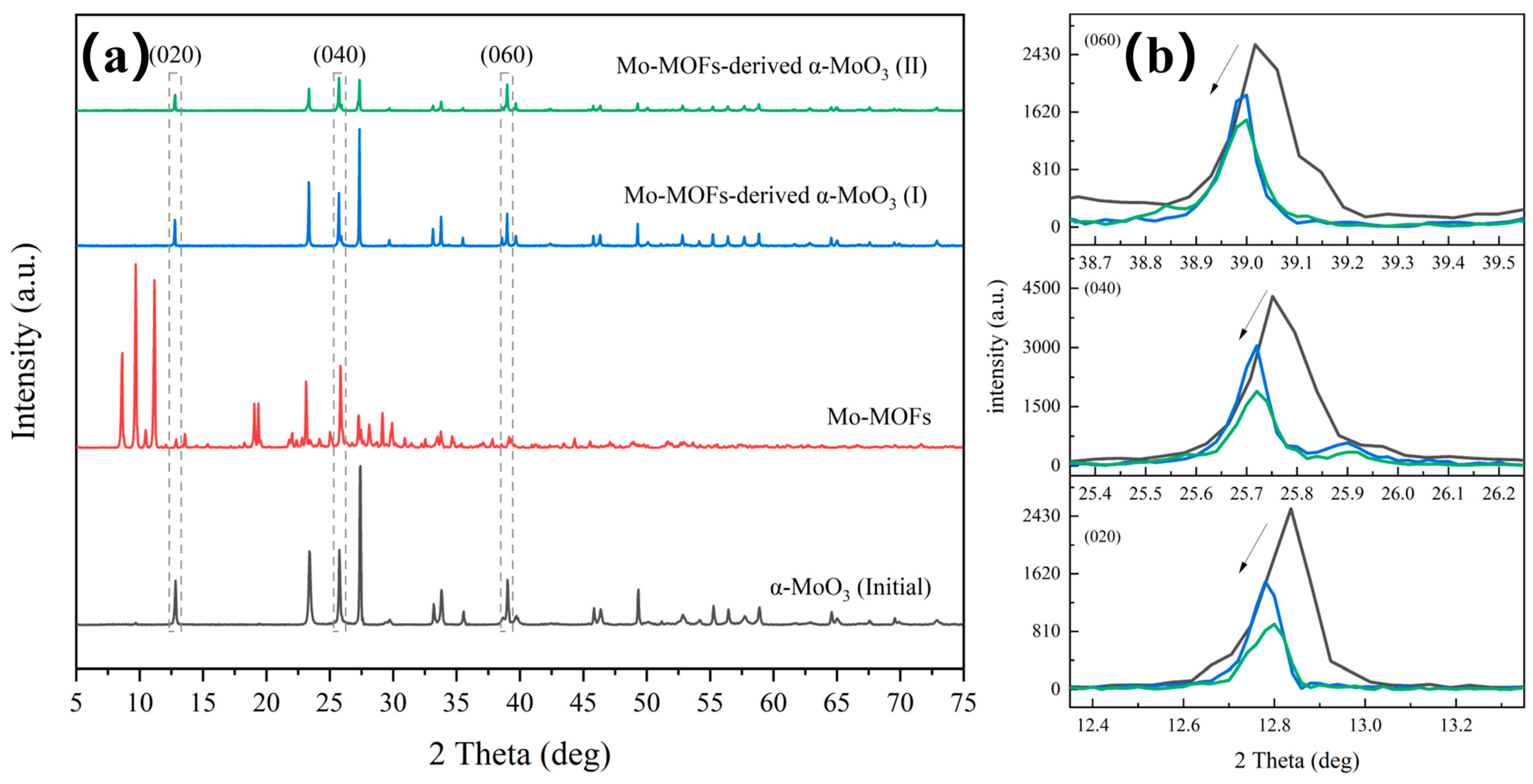
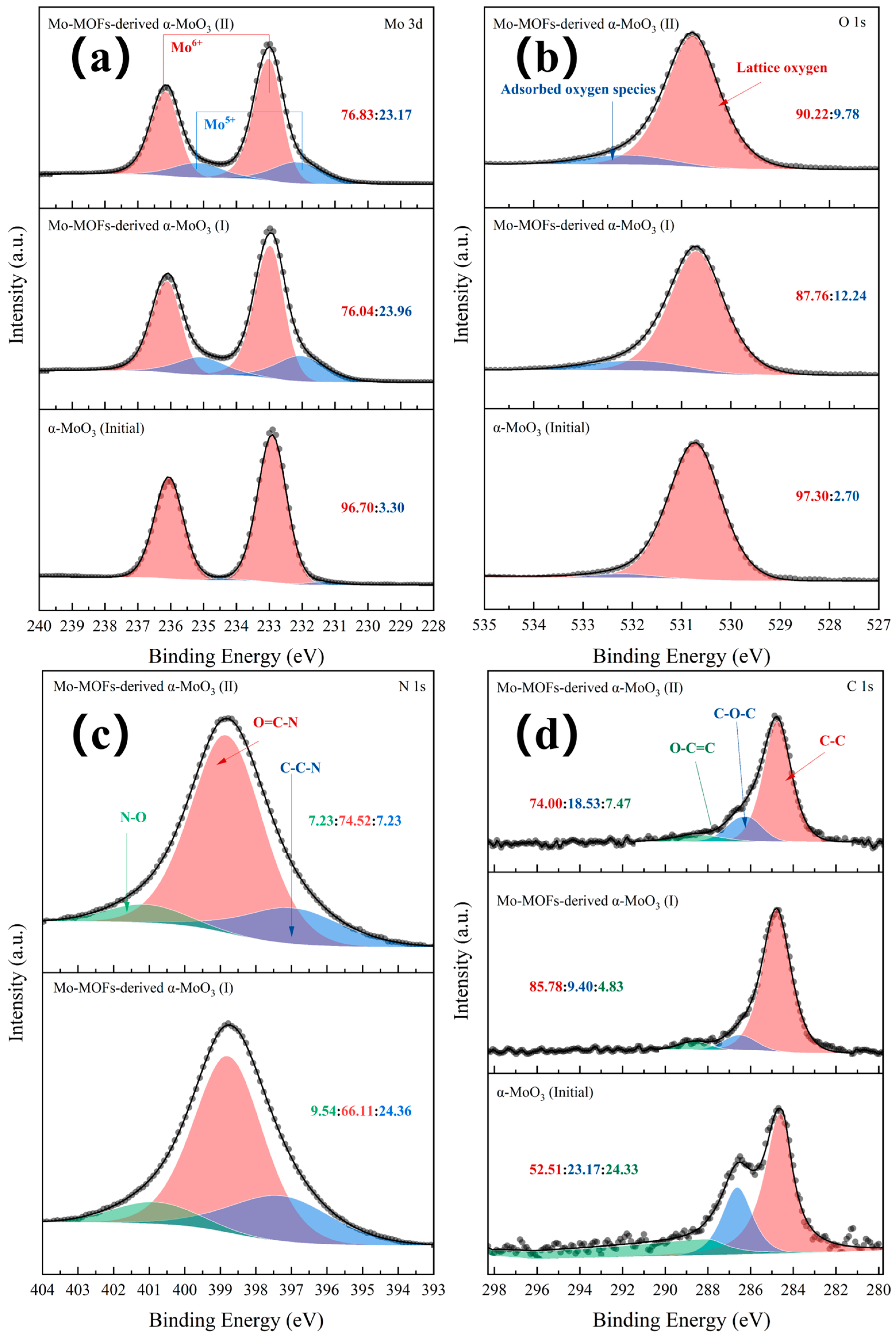
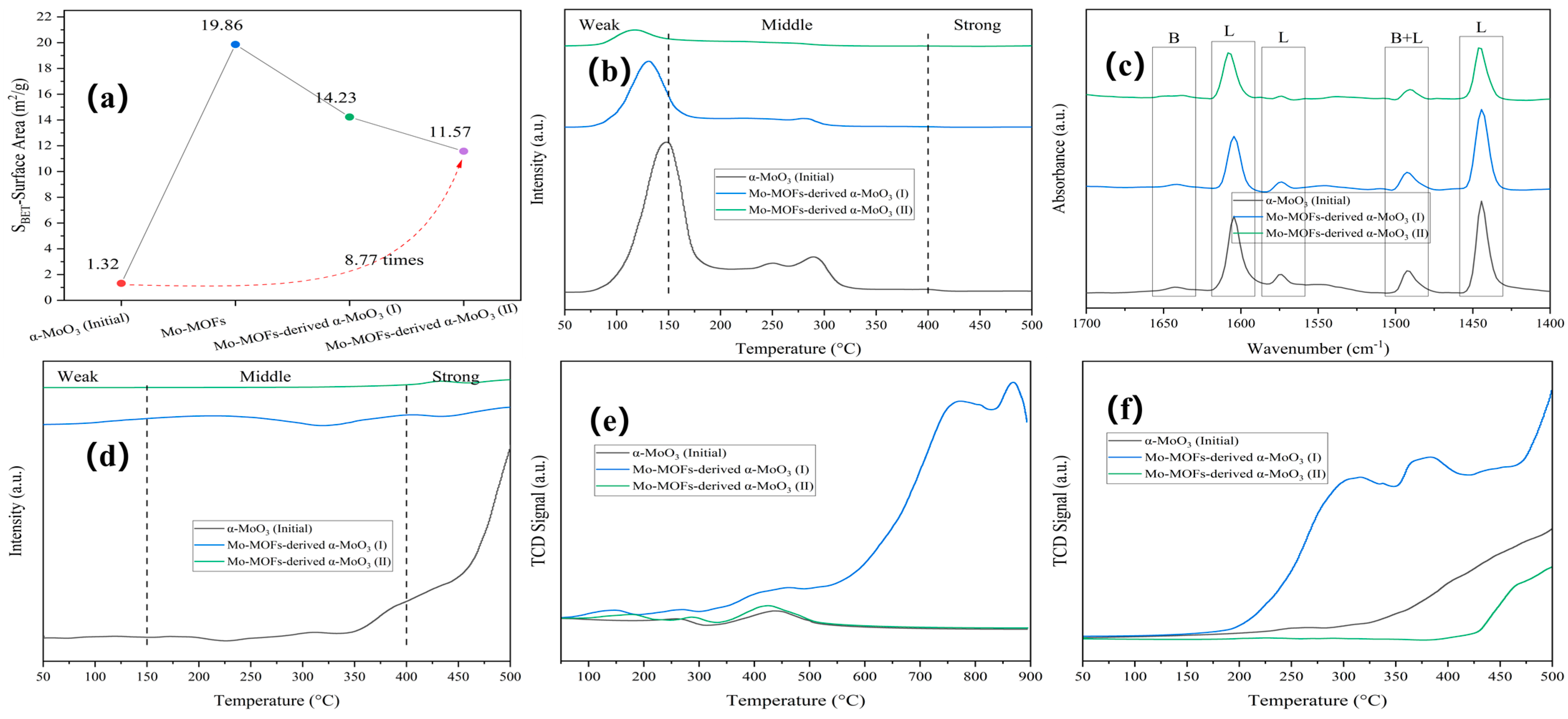
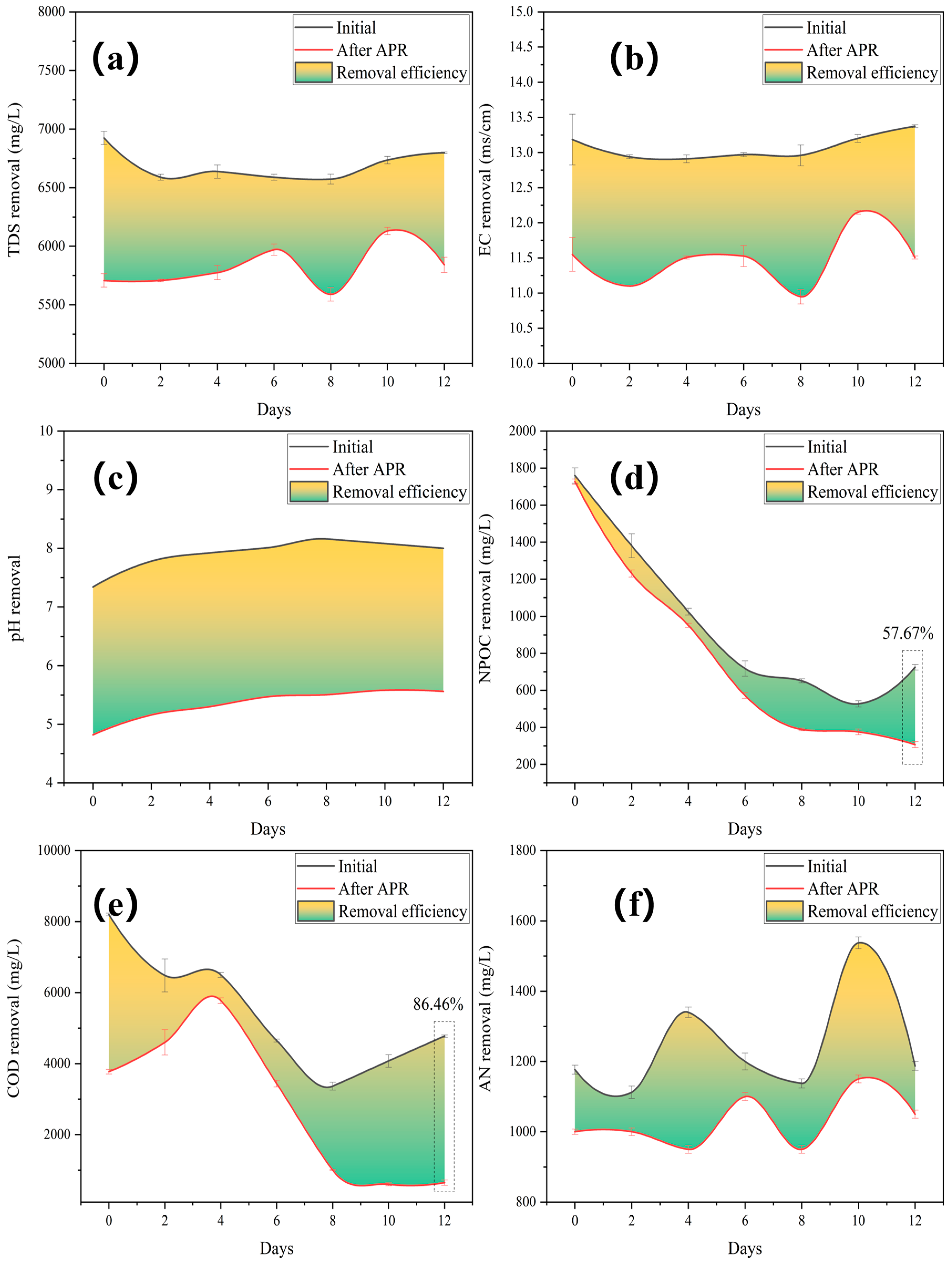
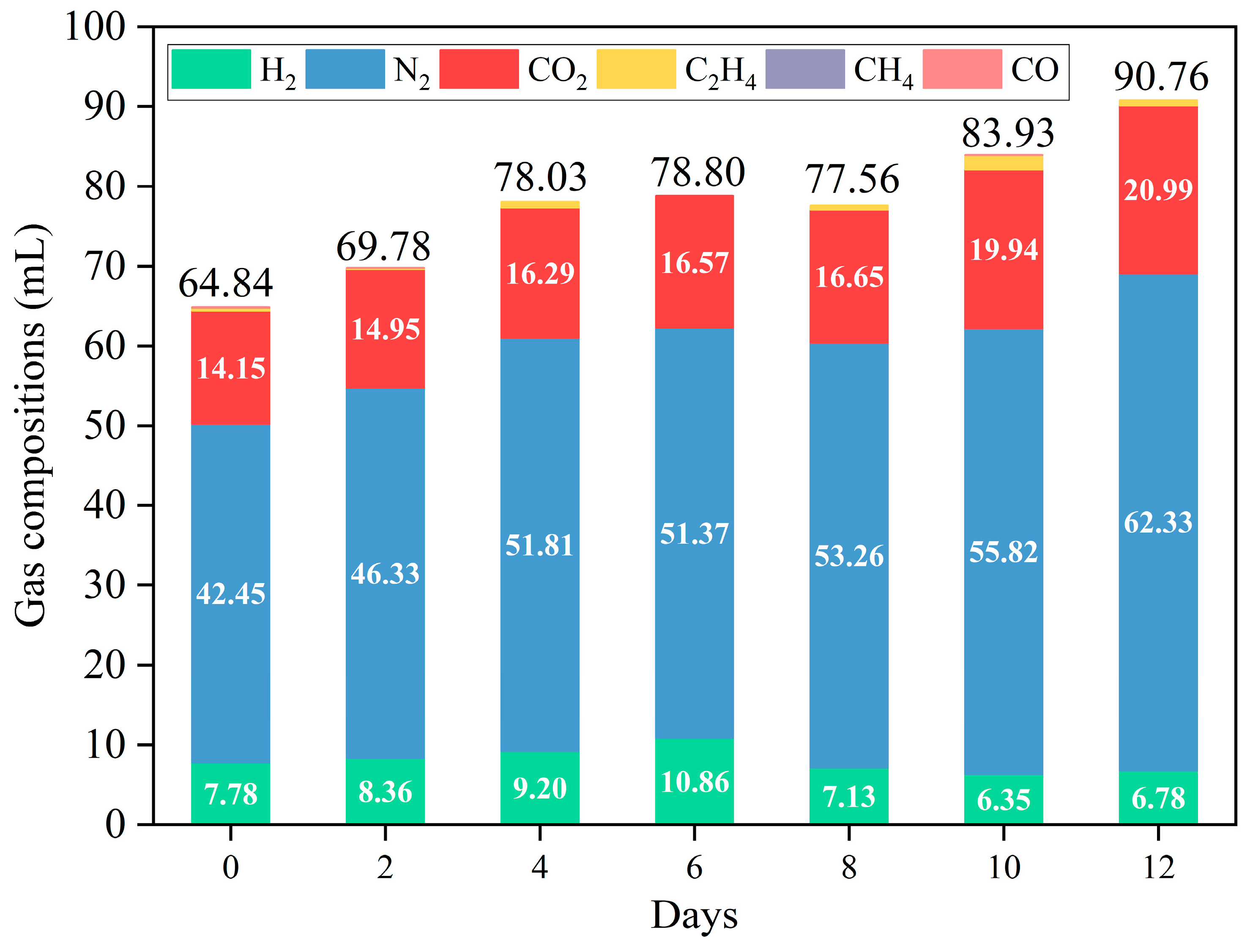


Disclaimer/Publisher’s Note: The statements, opinions and data contained in all publications are solely those of the individual author(s) and contributor(s) and not of MDPI and/or the editor(s). MDPI and/or the editor(s) disclaim responsibility for any injury to people or property resulting from any ideas, methods, instructions or products referred to in the content. |
© 2024 by the authors. Licensee MDPI, Basel, Switzerland. This article is an open access article distributed under the terms and conditions of the Creative Commons Attribution (CC BY) license (https://creativecommons.org/licenses/by/4.0/).
Share and Cite
Bu, Q.; Wang, J.; Chen, Y.; Tao, J.; Kumar, A.; Yan, B.; Chen, G. Aqueous-Phase Reforming of Biogas Slurry over MOF-Derived α-MoO3 Catalyst for Producing Renewable Hydrogen: Effect of Fermenting Time. Molecules 2024, 29, 5565. https://doi.org/10.3390/molecules29235565
Bu Q, Wang J, Chen Y, Tao J, Kumar A, Yan B, Chen G. Aqueous-Phase Reforming of Biogas Slurry over MOF-Derived α-MoO3 Catalyst for Producing Renewable Hydrogen: Effect of Fermenting Time. Molecules. 2024; 29(23):5565. https://doi.org/10.3390/molecules29235565
Chicago/Turabian StyleBu, Qingguo, Jian Wang, Yuxuan Chen, Junyu Tao, Akash Kumar, Beibei Yan, and Guanyi Chen. 2024. "Aqueous-Phase Reforming of Biogas Slurry over MOF-Derived α-MoO3 Catalyst for Producing Renewable Hydrogen: Effect of Fermenting Time" Molecules 29, no. 23: 5565. https://doi.org/10.3390/molecules29235565
APA StyleBu, Q., Wang, J., Chen, Y., Tao, J., Kumar, A., Yan, B., & Chen, G. (2024). Aqueous-Phase Reforming of Biogas Slurry over MOF-Derived α-MoO3 Catalyst for Producing Renewable Hydrogen: Effect of Fermenting Time. Molecules, 29(23), 5565. https://doi.org/10.3390/molecules29235565






